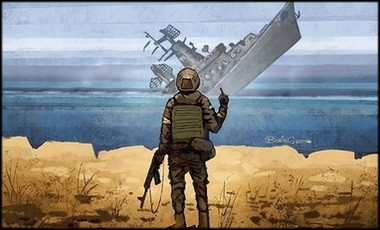The ship that Ukraine sank was the ship that reportedly took those guys on the island captive that told the ship to “go ‘effe’ yourself” when told to initially surrender… how the tables turn:
(Final Cut) Russian warship, idi na huy! Sound on! ?#Moskva #StandWithUkraine ???? MUSIC by: @MaxBarskih ORIGINAL ART by @BorisGrohArt pic.twitter.com/mUyzeu5c4v
— Russ Castella (@RussCastella) April 16, 2022
 News on the possibility that the Russian Missile Cruiser May Have Had Nuclear Weapons On Board, what the U.S. Military calls “Broken Arrow,” a situation with potentially lethal accidents involving nuclear weapons. DAILY MAIL:
News on the possibility that the Russian Missile Cruiser May Have Had Nuclear Weapons On Board, what the U.S. Military calls “Broken Arrow,” a situation with potentially lethal accidents involving nuclear weapons. DAILY MAIL:
Russia’s ‘broken arrow’: Fears that NUCLEAR MISSILES sank with Putin’s flagship Moskva amid claims that 452 of the 510 crew have drowned and top admiral has been arrested after cruiser was ‘hit by Ukrainian missile’
- Moskva, the flagship of Russia’s Black Sea fleet, has been confirmed to have sunk near port of Sevastopol
- Experts and analysts are now warning that the warship may have been carrying two nuclear warheads
- They are calling for an urgent probe into ‘broken arrow’ incident – military slang for an accident with nukes
- Meanwhile questions remain over the fate of Moskva’s 510-strong crew, most of whom are unaccounted for
- Ilya Ponomarev, a politician exiled from Russia, said as many as 452 members of the crew could have died
Russia’s Black Sea flagship which sank yesterday after an explosion on board may have been carrying nuclear warheads, analysts and experts have warned today, as a Russian politician said more than 400 sailors could have gone down with the ship.
The Moskva, a Soviet-era guided missile cruiser, sank near the port of Sevastopol on Thursday after Ukraine said it hit the ship with two cruise missiles. Today, Mykhailo Samus, director of a Lviv-based military think-tank; Andriy Klymenko, editor of Black Sea News; and Ukrainian newspaper Defence Express all warned that the Moskva could have been carrying two nuclear warheads designed to be fitted to its P-1000 ‘carrier killer’ missiles.
If true, the loss of the warheads into the Black Sea could spark a ‘Broken Arrow’ incident – American military slang for potentially lethal accidents involving nuclear weapons.
‘On board the Moskva could be nuclear warheads – two units,’ Samus said, while Klymenko called on other Black Sea nations – Turkey, Romania, Georgia, and Bulgaria – to insist on an explanation. ‘Where are these warheads? Where were they when the ammunition exploded,’ he asked.
Meanwhile Ilya Ponomarev, a politician exiled from Russia for opposing Putin’s 2014 annexation of Crimea, said just 58 of the 510-strong crew have since been accounted for – raising the prospect that 452 men went down with the ship in what would be a bitter loss for Vladimir Putin’s already beleaguered army.
The figure, while unconfirmed, is consistent with losses suffered on exploding warships. During the Russian Navy’s infamous defeat at the Battle of Tsushima against Japan, an explosion on board the Borodino – slightly smaller than the Moskva – saw all-but one of her 855 crew killed.
[….]
Leonid Nevzlin, a Russian-Israeli businessman who fled the country in 2003 after being targeted by Putin, said yesterday that 20 Russian generals have been arrested over the military’s failings along with 150 FSB officers for providing false information about Ukraine’s defences…..
The WASHINGTON POST has a good article as well noting that this anti-ship missile is 100% Ukraine made:
Soon after Russia seized Ukraine’s Crimean Peninsula in 2014, a Ukrainian defense firm used an arms show in Kyiv to unveil its latest project: an anti-ship cruise missile it called “Neptune.”
The new missile drew little attention at the time. But now it is in the spotlight after a U.S. defense official said Ukrainian forces used Neptune missiles to strike and sink Russia’s flagship Moskva war vessel in the Black Sea.
The strike on Wednesday marked a major boost for Ukraine — not only for its war effort but also for the homegrown arms industry, even as it relies on weapons donated by Western allies.
“For the Ukrainians, if they were able to sink this ship or damage it with their own Neptune missiles, that’s a point of pride, first, and a useful military capability in that they will be able to keep the Russian fleet at bay,” said Mark Cancian, senior adviser for the international security program at the Center for Strategic and International Studies.
[….]
“For the first time, a warship was destroyed by an anti-ship missile made entirely in Ukraine,” Daria Kaleniuk, executive director of the Anti-Corruption Action Center in Ukraine, wrote on Twitter.
The Neptune was in development before Russia’s annexation of Crimea, but the territory’s capture helped spur the missile’s production. The peninsula houses Ukraine’s main navy base and the Soviet-era coastal defense systems that had once protected the country from attack along the Black Sea.
The R-360 Neptune is itself based on an old Soviet cruise missile called the Kh-35, which had been produced in the Ukrainian town of Kharkiv. The company that developed Neptune, Luch Design Bureau, was founded in 1965 and had a long history of designing Soviet missiles.
If Neptune missiles were fired at the Moskva, it would mark the first time that the weapon was used in practice, military experts say. The incident also suggests that the cruise missile, which has a stated range of about 200 miles, can evade missile defense systems such as those onboard the Russian ship.
The ship was fitted with long-range radar and an S-300 air-defense system, designed to provide protection not only for itself but the rest of the Russian fleet. Accounts from Ukrainian officials suggest that an aerial drone was used to distract the defense systems during the attack……..
